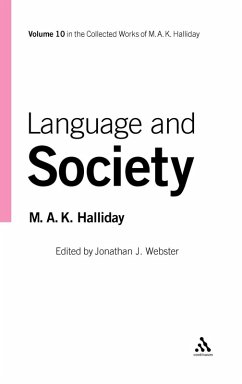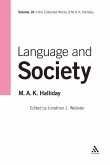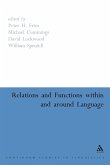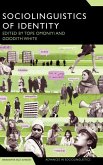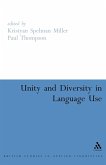Examines and analyses the relationship between language and society
The final volume in the 10 Volume M.A.K. Halliday series
- Language and Society is a key topic linguistics and sociolinguistics
- M.A.K Halliday is one of the most influential linguistics of the twentieth-century.
The tenth volume in Professor M.A.K. Halliday's collected works consist of papers focusing on Language and Society. The chapters provide a framework for understanding the social meaning of language, and the relation of language to other social phenomena. The volume begins with Professor Halliday's ground-breaking work on the users and uses of language. Subsequent chapters are organized around a discussion of sociolinguistic theory, and the relation between language, social class and social structure.
Table of Contents:
Preface
Acknowledgments
PART ONE: USERS AND USES
Editor’s Introduction
1. The Users and Uses of Language
PART TWO: SOCIOLINGUISTIC THEORY
Editor’s Introduction
2. Language in a Social Perspective
3. Language and Social Man
4. Sociological Aspects of Semantic Change
5. Language as Social Semiotic: Towards a General Sociolinguistic Theory
6. Some Aspects of Sociolinguistics
PART THREE: LANGUAGE AND SOCIAL CLASS
Editor’s Introduction
7. ‘Foreword’ to Basil Bernstein’s Class, Codes and Control Vol. II: Applied Studies towards a Sociology of Language
8. Language and the Theory of Codes
PART FOUR: LANGUAGE AND SOCIAL STRUCTURE
Editor’s Introduction
9. An Interpretation of the Functional Relationship between Language and Social Structure
10. Anti-languages
Bibliography
Review:
'...a major enterprise comparable to a grand retrospective of the painting of some prominent artist of a distinctive school.' Roy Harris, Times Literary Supplement
"I don’t recall what inspired so many of us most was it Michael Halliday’s Inaugural Address with its title ‘Grammar, Society and the Noun’, or the perhaps apocryphal remark that all linguistics is sociolinguistics; but what is crystal-clear in reading this final volume in his Collected Works edited with such care and devotion by Jonathan Webster for the benefit of all, is how modern it all reads with its interwoven links between texture and community, its implication of action in text - the can do, inherent in meaning potential but at the same time how definitive: the framework of analysis of an integrated general theory which now seems so much embedded in our modes of practice. Everyone will come away from this reading and re-reading of Michael Halliday’s writings on language and society with a different insight: for me it is two matters; every persons capacity for creativity in exploiting meaning potential, and the central importance of establishing a unifying system able not only to capture form but to relate it consequentially and functionally to our understandings of social life."
Chris Candlin, Senior Research Professor, Macquarie University, Sydney
The final volume in the 10 Volume M.A.K. Halliday series
- Language and Society is a key topic linguistics and sociolinguistics
- M.A.K Halliday is one of the most influential linguistics of the twentieth-century.
The tenth volume in Professor M.A.K. Halliday's collected works consist of papers focusing on Language and Society. The chapters provide a framework for understanding the social meaning of language, and the relation of language to other social phenomena. The volume begins with Professor Halliday's ground-breaking work on the users and uses of language. Subsequent chapters are organized around a discussion of sociolinguistic theory, and the relation between language, social class and social structure.
Table of Contents:
Preface
Acknowledgments
PART ONE: USERS AND USES
Editor’s Introduction
1. The Users and Uses of Language
PART TWO: SOCIOLINGUISTIC THEORY
Editor’s Introduction
2. Language in a Social Perspective
3. Language and Social Man
4. Sociological Aspects of Semantic Change
5. Language as Social Semiotic: Towards a General Sociolinguistic Theory
6. Some Aspects of Sociolinguistics
PART THREE: LANGUAGE AND SOCIAL CLASS
Editor’s Introduction
7. ‘Foreword’ to Basil Bernstein’s Class, Codes and Control Vol. II: Applied Studies towards a Sociology of Language
8. Language and the Theory of Codes
PART FOUR: LANGUAGE AND SOCIAL STRUCTURE
Editor’s Introduction
9. An Interpretation of the Functional Relationship between Language and Social Structure
10. Anti-languages
Bibliography
Review:
'...a major enterprise comparable to a grand retrospective of the painting of some prominent artist of a distinctive school.' Roy Harris, Times Literary Supplement
"I don’t recall what inspired so many of us most was it Michael Halliday’s Inaugural Address with its title ‘Grammar, Society and the Noun’, or the perhaps apocryphal remark that all linguistics is sociolinguistics; but what is crystal-clear in reading this final volume in his Collected Works edited with such care and devotion by Jonathan Webster for the benefit of all, is how modern it all reads with its interwoven links between texture and community, its implication of action in text - the can do, inherent in meaning potential but at the same time how definitive: the framework of analysis of an integrated general theory which now seems so much embedded in our modes of practice. Everyone will come away from this reading and re-reading of Michael Halliday’s writings on language and society with a different insight: for me it is two matters; every persons capacity for creativity in exploiting meaning potential, and the central importance of establishing a unifying system able not only to capture form but to relate it consequentially and functionally to our understandings of social life."
Chris Candlin, Senior Research Professor, Macquarie University, Sydney

